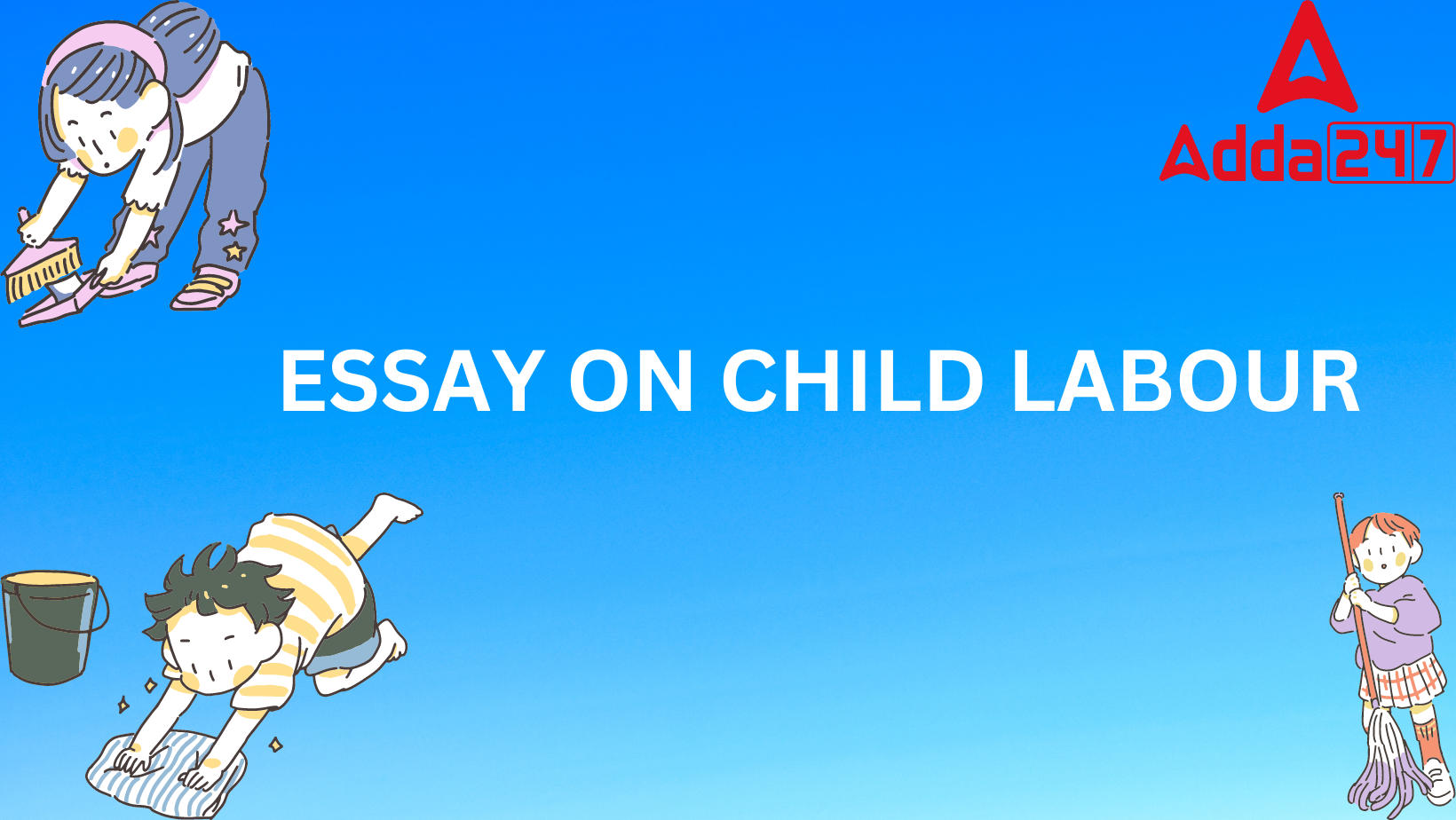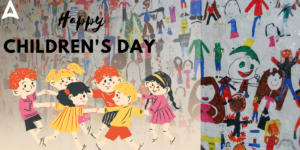Table of Contents
A child labour essay is a current trending topic for the students who are in the school to write essay. Most of the time students write an essay on child labour so here we are providing short and long essays on child labour. Before writing an essay on child labour we will understand in brief about child labour.
Child Labour Essay
The term “child labour” is typically described by the International Labour Organisation as work that
- destroys a child’s physical and mental development and robs them of their innocence, potential, and dignity. It refers to work that puts children at risk and harms them on a mental, physical, social, or moral level.
- It may also interfere with their education by preventing them from going to school, requiring them to leave early, or pushing them to try to balance school and overly heavy work.
Essay on Child Labour in 150 words
Childhood is undoubtedly the best and happiest stage of life for everyone. It is during this time that one learns the fundamentals of living from parents, close friends, and nature, as has always been emphasized in bedtime tales, advertisements, and by our elders. Everyone has the right to experience childhood from the minute they are born because it is the most memorable era of life. Children have the right to go to school, play with their friends, feel their parents’ love and care, and enjoy the beauty of nature.
Although children are seen as their nation’s most important resource, their parents’ ignorance and poverty make them the country’s weakness rather than its strength. Even with government awareness campaigns and future societal welfare for children, the majority of children living in poverty are still required to work as children on a daily basis. Children are a nation’s strength, but some people continue to try to undermine it and the future of the country by illegally involving developing children in order to earn fast cash. They are interfering with children’s and innocent people’s values.
Child Labour Essay in English
It is correct to say that child labour is a serious worry for society and a serious human rights violation that is preventing the growth and development of the nation. The term “child labour” refers to children who regularly work between the ages of five and fourteen. In order to live, many youngsters in underdeveloped countries are forced to work long hours for meagre pay.
The main causes of child labour around the world are poverty, parents, society, low wages, unemployment, subpar living conditions and understanding, social injustice, lack of education, backwardness, and insufficient restrictions. However, because of poverty, a lack of educational awareness, and a lack of educational opportunities, child labour is a problem in developing countries.
This horrible and cruel practice is harming the lives of countless defenceless children every day. Due to insufficient norms and laws, there is a high level of criminal behaviour that should be punished, and because it is occurring simultaneously, it has become one of India’s most urgent social problems that need to be handled on a regular basis. It is crucial to understand that happy, healthy children are a nation’s greatest asset and that child labour destroys both the prospects of the nation and the children who work there.
Child Labour Essay English in 1000 words
Imagine that the plant you water every day is about to bloom into a stunning flower that will fill your balcony with a spellbinding smell. Imagine waking up the following morning to see the budding blossom entirely ruined and choked. The bud no longer has the great potential to develop into a flower. Similar to how a flower bud is crushed, a child’s future is similarly destroyed when they are forced to work at a young age in our society, stealing away the fundamental aspects of their youth.
Simply said, child labour refers to the cruel practise of pushing young children to perform menial labour, robbing them of their fundamental rights to education and to the full development of the body and mind. They are deprived of the chance to pursue an education and are compelled to support the family financially. Children are therefore prevented from developing the necessary abilities and academic opportunities to develop into mature, educated adults.
Considered as the little gifts of God, children stuck in the vicious circle of child labour can be seen working at restaurants, households, factories, constructions, etc. In India, you might have come across small children selling pens, candies, flowers and other things on the streets and traffic lights as well. Due to financial issues in their families, they are forced to pursue menial jobs and step into the harsh realities of the world at an early age.
Lack of educational opportunities, inequality, traditional and cultural expectations and stagnant demographic transitions majorly foster child labour in India. As per the 2011 Census, there are 10.1 million working children between the age of 5-14. With more and more children being pushed to work every now and then, child labour has been a constant stigma to tackle. Several interlinked factors contribute to the persistence of this social evil in the country. Skyrocketing prices of the basic utilities and high unemployment and poverty levels are the basic reasons why children are forced to earn for their families.
It’s also critical to comprehend and learn how to distinguish between child labour and non-child work. Having said that, it is important to recognise that not all employment done by children is considered child labour and should be targeted for removal. Participation in work by children or adolescents that does not harm their health or development or interfere with their education is typically considered a positive thing. Helping their parents around the house, assisting in a family company, or earning pocket money outside of school hours and during school holidays are examples of such activities. These types of activities aid in the development of children and the well-being of their families by providing them with skills and experience, as well as preparing them to be useful members of society as adults.
Based on Census 2011, the total child population in India in the age group (5-14) years is 259.6 million, out of which are either working as a ‘main workers’ or as a ‘marginal workers’. To extract the children out of these harsh situations, the Indian Government has laid down various laws including the restriction of employment of children below the age of 14 in any of the factories or mines.
Despite many government departments and commissions working on the eradication of this practice, it is still prevailing in urban and rural areas. Thus, in order to fight this social evil, we must ensure that children are provided with their basic right to education for free and awareness about the perils of child labour should be spread in rural and urban areas to exterminate it at its roots.
Child labor has profound and often devastating impacts on children, affecting their physical, mental, and emotional well-being. Here are some of the major effects:
Health Risks
- Physical Harm: Many child laborers work in hazardous conditions, leading to injuries, exposure to harmful chemicals, and long-term health issues.
- Malnutrition: Long working hours and poor working conditions often prevent children from getting proper nutrition, leading to stunted growth and development.
- Mental Health: The stress and trauma associated with child labor can result in mental health issues like anxiety, depression, and low self-esteem.
Education
- Interrupted Schooling: Child labor often forces children to drop out of school or prevents them from attending altogether, leading to illiteracy and a lack of basic education.
- Future Opportunities: Without education, these children are trapped in a cycle of poverty, as they lack the skills necessary for better-paying jobs in the future.
Social Development
- Isolation: Working long hours isolates children from their peers, hindering their social development and limiting their ability to form relationships.
- Loss of Childhood: Child labor deprives children of the joys of childhood, forcing them into adult responsibilities far too early.
Economic Impact
- Perpetuation of Poverty: Child labor perpetuates poverty within families, as children are paid minimal wages, which do not contribute significantly to improving the family’s economic situation.
- Economic Exploitation: Employers often exploit child laborers by paying them less than adults, contributing to the cycle of poverty.
Legal and Ethical Concerns
- Violation of Rights: Child labor is a violation of children’s rights, denying them their right to education, play, and a safe environment.
- Moral Impact: It raises ethical concerns about the exploitation of vulnerable populations and the responsibilities of society and governments to protect children.
Long-term Consequences
- Chronic Poverty: Children who grow up without education and health suffer long-term poverty, leading to generational cycles of exploitation and hardship.
- Societal Impact: A society with high levels of child labor suffers from increased inequality, lower overall productivity, and slower economic development.
Conclusion
The impact of child labor on children is overwhelmingly negative, affecting all aspects of their lives and futures. Addressing this issue requires coordinated efforts from governments, communities, and international organizations to enforce laws, provide education, and protect the rights of children worldwide.
Child Labour in India Essay in Hindi- बाल श्रम निबंध
यह कहना सही है कि बाल श्रम समाज के लिए एक गंभीर चिंता और मानवाधिकारों का गंभीर उल्लंघन है जो राष्ट्र के विकास और विकास को रोक रहा है। शब्द “बाल श्रम” उन बच्चों को संदर्भित करता है जो नियमित रूप से पांच और चौदह वर्ष की आयु के बीच काम करते हैं। जीने के लिए, अविकसित देशों में कई युवा अल्प वेतन के लिए लंबे समय तक काम करने के लिए मजबूर हैं।
दुनिया भर में बाल श्रम के मुख्य कारण गरीबी, माता-पिता, समाज, कम मजदूरी, बेरोजगारी, निम्न जीवन स्थितियों और समझ, सामाजिक अन्याय, शिक्षा की कमी, पिछड़ापन और अपर्याप्त प्रतिबंध हैं। हालाँकि, गरीबी, शैक्षिक जागरूकता की कमी और शैक्षिक अवसरों की कमी के कारण विकासशील देशों में बाल श्रम एक समस्या है।
यह भयानक और क्रूर प्रथा हर दिन अनगिनत रक्षाहीन बच्चों के जीवन को नुकसान पहुंचा रही है। अपर्याप्त मानदंडों और कानूनों के कारण, उच्च स्तर का आपराधिक व्यवहार होता है जिसे दंडित किया जाना चाहिए, और क्योंकि यह एक साथ हो रहा है, यह भारत की सबसे जरूरी सामाजिक समस्याओं में से एक बन गया है जिसे नियमित आधार पर संभालने की आवश्यकता है। यह समझना महत्वपूर्ण है कि खुश, स्वस्थ बच्चे देश की सबसे बड़ी संपत्ति हैं और बाल श्रम राष्ट्र की संभावनाओं और वहां काम करने वाले बच्चों दोनों को नष्ट कर देता है।
कल्पना कीजिए कि जिस पौधे को आप प्रतिदिन पानी देते हैं, वह एक तेजस्वी फूल के रूप में खिलने वाला है जो आपकी बालकनी को मंत्रमुग्ध कर देने वाली गंध से भर देगा। कल्पना कीजिए कि अगली सुबह उठने के बाद यह देखने के लिए कि नवोदित फूल पूरी तरह से बर्बाद और घुटा हुआ है। कली में अब फूल के रूप में विकसित होने की बहुत अधिक क्षमता नहीं है। जिस तरह एक फूल की कली को कुचल दिया जाता है, उसी तरह एक बच्चे का भविष्य तबाह हो जाता है जब हमारे समाज में उन्हें कम उम्र में काम करने के लिए मजबूर किया जाता है, उनकी युवावस्था के मूलभूत पहलुओं को चुरा लिया जाता है।
सीधे शब्दों में कहा जाए तो बाल श्रम का तात्पर्य छोटे बच्चों को छोटे-मोटे काम करने के लिए धकेलने की क्रूर प्रथा से है, जिससे शिक्षा के उनके मौलिक अधिकारों को छीन लिया जाता है और शरीर और दिमाग का पूर्ण विकास किया जाता है। वे शिक्षा प्राप्त करने के अवसर से वंचित हैं और आर्थिक रूप से परिवार का समर्थन करने के लिए मजबूर हैं। इसलिए बच्चों को परिपक्व, शिक्षित वयस्कों में विकसित होने के लिए आवश्यक क्षमताओं और शैक्षणिक अवसरों को विकसित करने से रोका जाता है।
भगवान के छोटे उपहारों के रूप में माना जाता है, बाल श्रम के दुष्चक्र में फंसे बच्चों को रेस्तरां, घरों, कारखानों, निर्माण आदि में काम करते देखा जा सकता है। भारत में, आपने पेन, कैंडी, फूल और अन्य बेचने वाले छोटे बच्चों को देखा होगा। सड़कों और ट्रैफिक लाइट पर भी चीजें। अपने परिवारों में वित्तीय मुद्दों के कारण, उन्हें कम उम्र में ही नौकरी करने और दुनिया की कठोर वास्तविकताओं में कदम रखने के लिए मजबूर होना पड़ता है।
शैक्षिक अवसरों की कमी, असमानता, पारंपरिक और सांस्कृतिक अपेक्षाएं और स्थिर जनसांख्यिकीय परिवर्तन भारत में बाल श्रम को प्रमुख रूप से बढ़ावा देते हैं। 2011 की जनगणना के अनुसार, 5-14 वर्ष की आयु के बीच 10.1 मिलियन कामकाजी बच्चे हैं। अधिक से अधिक बच्चों को समय-समय पर काम पर धकेलने के साथ, बाल श्रम से निपटने के लिए एक निरंतर कलंक रहा है। कई परस्पर जुड़े कारक देश में इस सामाजिक बुराई के बने रहने में योगदान करते हैं। बुनियादी सुविधाओं की आसमान छूती कीमतें और उच्च बेरोजगारी और गरीबी का स्तर बच्चों को अपने परिवारों के लिए कमाने के लिए मजबूर करने के मूल कारण हैं।
बाल श्रम और गैर-बाल कार्य के बीच अंतर करना समझना और सीखना भी महत्वपूर्ण है। यह कहने के बाद, यह पहचानना महत्वपूर्ण है कि बच्चों द्वारा किए गए सभी रोजगार बाल श्रम नहीं माने जाते हैं और उन्हें हटाने के लिए लक्षित किया जाना चाहिए। बच्चों या किशोरों द्वारा काम में भागीदारी जो उनके स्वास्थ्य या विकास को नुकसान नहीं पहुंचाती है या उनकी शिक्षा में हस्तक्षेप नहीं करती है, आमतौर पर एक सकारात्मक बात मानी जाती है। घर के आसपास अपने माता-पिता की मदद करना, किसी पारिवारिक कंपनी में सहायता करना, या स्कूल के समय के बाहर और स्कूल की छुट्टियों के दौरान पॉकेट मनी अर्जित करना ऐसी गतिविधियों के उदाहरण हैं। इस प्रकार की गतिविधियाँ बच्चों के विकास और उनके परिवारों की भलाई के लिए उन्हें कौशल और अनुभव प्रदान करने के साथ-साथ उन्हें वयस्कों के रूप में समाज के उपयोगी सदस्य बनने के लिए तैयार करने में सहायता करती हैं।
2011 की जनगणना के आधार पर, भारत में (5-14) आयु वर्ग के बच्चों की कुल आबादी 259.6 मिलियन है, जिनमें से या तो ‘मुख्य कार्यकर्ता’ के रूप में या ‘सीमांत श्रमिकों’ के रूप में काम कर रहे हैं। इन कठोर परिस्थितियों से बच्चों को निकालने के लिए, भारत सरकार ने 14 वर्ष से कम उम्र के बच्चों के किसी भी कारखाने या खदान में रोजगार पर प्रतिबंध सहित विभिन्न कानून बनाए हैं।
इस प्रथा के उन्मूलन पर कई सरकारी विभागों और आयोगों के काम करने के बावजूद, यह अभी भी शहरी और ग्रामीण क्षेत्रों में प्रचलित है। इस प्रकार, इस सामाजिक बुराई से लड़ने के लिए, हमें यह सुनिश्चित करना चाहिए कि बच्चों को मुफ्त और जागरूकता के लिए शिक्षा का उनका मूल अधिकार प्रदान किया जाए। बाल श्रम के खतरों के बारे में ग्रामीण और शहरी क्षेत्रों में फैलाया जाना चाहिए ताकि इसे जड़ से खत्म किया जा सके।
Related Articles:
Here we are providing you with a list of some common essay topics
| Diwali Festival | Environmental Pollution |
| Mahatma Gandhi | Our country: India |
| Climate change | My aim in life |
| Morning Walk | Online Education |
| Cow essay |
![Child Labour Essay in English [150 Words]- Check Its Impact_0.1](https://www.adda247.com/jobs/wp-content/uploads/sites/2/2022/09/07185734/school.png)

![Child Labour Essay in English [150 Words]- Check Its Impact_3.1](https://www.adda247.com/jobs/wp-content/uploads/sites/2/2025/04/08184254/Free-CUET-Mock-Test-2025.jpeg)
 Jawaharlal Nehru Essay for Students, Dow...
Jawaharlal Nehru Essay for Students, Dow...
 बाल दिवस पर निब�...
बाल दिवस पर निब�...
 My Best Friend Essay in English, Best Fr...
My Best Friend Essay in English, Best Fr...
![Child Labour Essay in English [150 Words]- Check Its Impact_4.1](https://st.adda247.com/https://storeimages.adda247.com/OnrProMaxDropper1743080113.jpeg?tr=w-undefined)


![Child Labour Essay in English [150 Words]- Check Its Impact_7.1](https://st.adda247.com/https://storeimages.adda247.com/901171741694185.png?tr=w-undefined)
![Child Labour Essay in English [150 Words]- Check Its Impact_8.1](https://st.adda247.com/https://storeimages.adda247.com/901291741780012.jpeg?tr=w-undefined)
![Child Labour Essay in English [150 Words]- Check Its Impact_9.1](https://st.adda247.com/https://storeimages.adda247.com/901271741781632.jpeg?tr=w-undefined)
![Child Labour Essay in English [150 Words]- Check Its Impact_10.1](https://st.adda247.com/https://storeimages.adda247.com/901761741788315.jpg?tr=w-undefined)
![Child Labour Essay in English [150 Words]- Check Its Impact_11.1](https://st.adda247.com/https://storeimages.adda247.com/901741741788360.jpg?tr=w-undefined)
![Child Labour Essay in English [150 Words]- Check Its Impact_12.1](https://st.adda247.com/https://storeimages.adda247.com/321761715859818.jpeg?tr=w-undefined)
![Child Labour Essay in English [150 Words]- Check Its Impact_13.1](https://st.adda247.com/https://storeimages.adda247.com/440701715859668.jpeg?tr=w-undefined)
